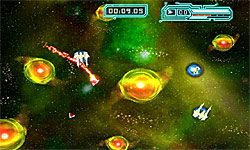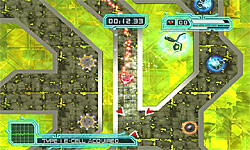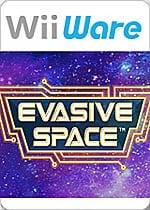It’s hard to find an observer of the video game industry who isn’t excited about High Voltage Software. The company promises, through its upcoming Wii title The Conduit, to bring Nintendo’s console up-to-speed with the first-person shooter genre, in terms of both graphics and gameplay.

Unfortunately, the developer could undermine that excitement with Evasive Space (ES), an somewhat unimpressive WiiWare download that runs on the same engine that The Conduit will – Quantum3. The graphics are indeed nice, but Evasive Space’s bland and frustrating gameplay calls into question the developer’s ability to polish levels and fine-tune a control scheme.
High Voltage has made the claim that Quantum3 will enable Xbox 360/PlayStation 3-caliber graphics on the Wii. Adjusting for the Wii’s 480p resolution cap, Evasive Space makes that assertion believable, even if it doesn’t quite prove it. ES looks a lot like an Xbox Live Arcade shooter, with detailed and colorful environments rendered in 3-D despite the 2-D gameplay. You’ll notice lots of well-done effects like shading and particles as well. This game is very simple, so it’s not clear whether Quantum3 will perform so well in a first-person environment with lots of textures and complex enemy A.I., but the visuals in Evasive Space are a positive sign.
Viewed as a game in itself rather than a technology demo, however, Evasive Space doesn’t fare well. It’s very innovative in several ways, but those innovations end up being the game’s downfall: they’re either poorly executed or downright unworkable.

Evasive Space is essentially a maze game that looks like a 2-D top-down shooter, or perhaps it’s better described as a 2-D top-down shooter in which you can’t shoot. The idea is to get from each level’s beginning to its end within the time limit, collecting various items as you go. You lose time recovering from run-ins with enemies and walls, and some stages have one-hit-fatal hazards.
This isn’t a terrible idea for a game. It capitalizes on the current arcade-shooter fad without resigning to the genre’s played-out conventions. By cutting out the shooting component, Evasive Space puts the emphasis on fast, agile, precise movements. The problem is that the idea wasn’t executed well: the level design isn’t that great.

In some levels, you wind your way through ridiculously tight spaces, trying to figure out which warps to go through to finish the level. It often seems like a random jumble of paths with cheap-shot enemies placed here and there. What’s especially frustrating is that when you run out of time, you can’t keep exploring the level to figure out how to play it next time the countdown starts (actually, for some reason, it counts up). You have to keep starting from the beginning, trying out each prong of each fork in the road until you find the right ones. Most of the levels aren’t long, so it’s not like they’ll take hours to figure out, but it’s annoying to learn to navigate a maze in 45-second chunks of time. At the very least, High Voltage could have let us control the zoom so we could see the entire maze at once.
Other levels take place in open space, asking you to accomplish tasks like “collect X number of Y-type power-ups in Z seconds.” These levels will often change the rules to make the game more hazardous, like making the screen move on its own, killing you if you touch the edge. These are more manageable, as there isn’t as much emphasis on memorizing each and every turn, but they’re not as innovative, as the maze element is just about gone.
Even given the aforementioned flaws, the game would be a worthwhile download for lots of gamers: those who like shooters but want a change, those who like mazes, and those who are just curious what Quantum3 has to offer and wouldn’t mind buying and playing a so-so game to see it. What really destroys Evasive Space is the control scheme; a ham-handed attempt to incorporate Wii-mote waggling into the arcade-shooter format.

There are several control schemes that have served arcade shooters well for decades. All involve joysticks. In the most simple one, you just push the stick in the direction you want to fly. In another, you turn your ship to the left and right by pushing the stick left and right (which admittedly gets confusing when your ship is pointed down, because you have to turn it to the left to make it head toward the right side of the screen). These weren’t good enough for Evasive Space. Rather, here you point the Wii-mote at the screen and push the B button to propel the ship. The ship turns and flies straight toward the location on the screen where you’re pointing. The best tactic we could find was to keep the pointer very close to the ship, and swivel it around whenever the course called for a turn. There’s no option to change to a more standard setup.
As far as Wii controls go, this is worse than tacked-on; it’s downright harmful. These mazes demand precision, and instead of having direct control over your vehicle, you have to wave around a pointer to direct the ship around the screen. The result ranges from annoyance on the earlier levels to infuriation on the harder ones. The setup actually makes the game less realistic too, because it doesn’t feel like steering at all.
Besides the 20-level single-player mode, there’s four-player single-screen offline multiplayer that’s reasonably entertaining; there are several ways to compete, such as trying to get the most power-ups. There’s no online multiplayer, but there are online leaderboards. For players who do manage to get into this game, these additions will provide replay value.
It’s probably not fair to expect so much from a developer just because they’ve made some aggressive claims about a game they’ve not even finished yet. Still, with so many hopes pinned to The Conduit, it’s hard not to cringe a little at the mistakes in Evasive Space. The game takes an innovative premise and executes it in a way that’s incredibly frustrating to deal with. It’s so frustrating, in fact, that few people will find it worth the $10 asking price.
RATING OUT OF 5 RATING DESCRIPTION 4.6 Graphics
Very nice, especially for a Wii Ware title. The gameplay is 2-D, but the visuals are rendered in 3-D with all sorts of shading and particle effects. 1.5 Control
A needless and cumbersome deviation from the standard arcade-shooter setup. 3.5 Music / Sound FX / Voice Acting
No complaints here. The sound effects are pretty standard for the genre, and the music stays out of the way. 3.2
Play Value
This is a very frustrating game, thanks to the difficult level design and unusable control scheme. It’s unlikely to grab a hold of you and compel you to complete the whole thing. On the other hand, if this game is your thing, there’s replay value provided through the multiplayer and leaderboards.
3.0 Overall Rating – Fair
Not an average. See Rating legend above for a final score breakdown.
Game Features:
